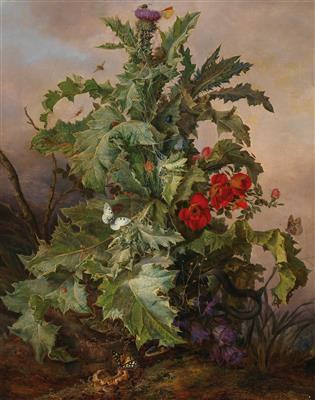Franz Xaver Gruber

(Vienna 1801–1862)
Large thistle still life with poppies, butterflies, spider and snake, signed,
oil on canvas, 80 x 65 cm, framed, (Rei)
Provenance:
Private Collection, Sweden
It is easy to understand the nickname “Distelgruber” (“Thistle Gruber”), by which Franz Xaver Gruber is still known, when considering this work. Gruber completed a variation on this theme in 1854, which was presented a year later at the Paris World Exhibition. The subject of the painting initiated lively discussions and received many positive reviews.
Gruber, who was trained at the Viennese Academy, could call back to a rich repertoire of plant and flower paintings of previous generations. For one thing, the imperial Picture Gallery featured many works of Dutch flower painters of the 17th and 18th centuries; for another, he had such outstanding colleagues and role-models as the painters Johann Baptist Drechsler, Sebastian Wegmeyer and Franz Xaver Petter. Besides this, the artist attended lectures on the subject of botany at the University of Vienna, which gave him access to a scientific approach to the theme.
Spurred on by his success at the World Exhibition, Gruber completed further still lifes of thistles. It is said that he finished eleven paintings on this subject, one of which was owned by the painter Friedrich von Amerling. With the thistle as his central motif, Gruber chooses a plant known neither for its loveliness nor its beauty. Nonetheless, the artist is able to master the motif with bravura. Just as in the larger format version of 1854, here Gruber chooses poppies and animals as secondary motifs. In prominent position, the plant dominates the whole painting, with the view leading into the clouded sky in the background. The barbs and leaves of the thistle, as well as the spider’s web, make clear his talent in the treatment of various surfaces and show once more his intensive engagement with flora and fauna. The butterflies are rendered so realistically that one might imagine oneself catching them beating their wings at any moment. The snake creeping out from under the leaf seems to be sitting in ambush. Enriched through countless details, the viewer is able to constantly discover something new. Despite the near-scientific exactness with which Gruber takes on his theme, the demand of art takes highest position in his works. He proves himself a tireless spirit, who besides his rich production of paintings and watercolours was also an outstanding, dedicated teacher to his pupils, whom he taught at the manufacturing school of Vienna, amongst other places, which then belonged to the Academy. After the fall of Prince Metternich, Gruber was deprived of his teaching duties, having been in the favour of the despised state chancellor, and so from then on had to rely on work for private clients. This setback, however, spurned him on to greater achievements, as shown by the series of thistle paintings. Botanists such as Joseph Georg Beer also made use of his artistic talent in the representation of plants and flowers for scientific purposes. His name was the epitome of flower painting of the highest artistic quality in 19th century Vienna.
Compare:
Friedrich von Boetticher, Malerwerke des 19. Jahrhunderts, Hofheim am Taunus 1979, vol. I, 1, p. 443, no. 6; Franz Xaver Gruber 1801–1862, monograph on the occasion of the exhibition “Der Wiener Blumenmaler Franz Xaver Gruber”, 31 October – 9 November 2008, Palais Niederösterreich, Edition Szaal 2008, p. 54, ill. p. 55.
Esperta: Mag. Dimitra Reimüller
 Mag. Dimitra Reimüller
Mag. Dimitra Reimüller
+43-1-515 60-355
19c.paintings@dorotheum.at
20.10.2016 - 18:00
- Prezzo realizzato: **
-
EUR 50.000,-
- Stima:
-
EUR 25.000,- a EUR 35.000,-
Franz Xaver Gruber
(Vienna 1801–1862)
Large thistle still life with poppies, butterflies, spider and snake, signed,
oil on canvas, 80 x 65 cm, framed, (Rei)
Provenance:
Private Collection, Sweden
It is easy to understand the nickname “Distelgruber” (“Thistle Gruber”), by which Franz Xaver Gruber is still known, when considering this work. Gruber completed a variation on this theme in 1854, which was presented a year later at the Paris World Exhibition. The subject of the painting initiated lively discussions and received many positive reviews.
Gruber, who was trained at the Viennese Academy, could call back to a rich repertoire of plant and flower paintings of previous generations. For one thing, the imperial Picture Gallery featured many works of Dutch flower painters of the 17th and 18th centuries; for another, he had such outstanding colleagues and role-models as the painters Johann Baptist Drechsler, Sebastian Wegmeyer and Franz Xaver Petter. Besides this, the artist attended lectures on the subject of botany at the University of Vienna, which gave him access to a scientific approach to the theme.
Spurred on by his success at the World Exhibition, Gruber completed further still lifes of thistles. It is said that he finished eleven paintings on this subject, one of which was owned by the painter Friedrich von Amerling. With the thistle as his central motif, Gruber chooses a plant known neither for its loveliness nor its beauty. Nonetheless, the artist is able to master the motif with bravura. Just as in the larger format version of 1854, here Gruber chooses poppies and animals as secondary motifs. In prominent position, the plant dominates the whole painting, with the view leading into the clouded sky in the background. The barbs and leaves of the thistle, as well as the spider’s web, make clear his talent in the treatment of various surfaces and show once more his intensive engagement with flora and fauna. The butterflies are rendered so realistically that one might imagine oneself catching them beating their wings at any moment. The snake creeping out from under the leaf seems to be sitting in ambush. Enriched through countless details, the viewer is able to constantly discover something new. Despite the near-scientific exactness with which Gruber takes on his theme, the demand of art takes highest position in his works. He proves himself a tireless spirit, who besides his rich production of paintings and watercolours was also an outstanding, dedicated teacher to his pupils, whom he taught at the manufacturing school of Vienna, amongst other places, which then belonged to the Academy. After the fall of Prince Metternich, Gruber was deprived of his teaching duties, having been in the favour of the despised state chancellor, and so from then on had to rely on work for private clients. This setback, however, spurned him on to greater achievements, as shown by the series of thistle paintings. Botanists such as Joseph Georg Beer also made use of his artistic talent in the representation of plants and flowers for scientific purposes. His name was the epitome of flower painting of the highest artistic quality in 19th century Vienna.
Compare:
Friedrich von Boetticher, Malerwerke des 19. Jahrhunderts, Hofheim am Taunus 1979, vol. I, 1, p. 443, no. 6; Franz Xaver Gruber 1801–1862, monograph on the occasion of the exhibition “Der Wiener Blumenmaler Franz Xaver Gruber”, 31 October – 9 November 2008, Palais Niederösterreich, Edition Szaal 2008, p. 54, ill. p. 55.
Esperta: Mag. Dimitra Reimüller
 Mag. Dimitra Reimüller
Mag. Dimitra Reimüller
+43-1-515 60-355
19c.paintings@dorotheum.at
|
Hotline dell'acquirente
lun-ven: 10.00 - 17.00
kundendienst@dorotheum.at +43 1 515 60 200 |
| Asta: | Dipinti dell’Ottocento |
| Tipo d'asta: | Asta in sala |
| Data: | 20.10.2016 - 18:00 |
| Luogo dell'asta: | Wien | Palais Dorotheum |
| Esposizione: | 08.10. - 20.10.2016 |
** Prezzo d'acquisto comprensivo di tassa di vendita e IVA
Non è più possibile effettuare un ordine di acquisto su Internet. L'asta è in preparazione o è già stata eseguita.
Altri oggetti dell'artista
-

Stima:
EUR 10.000,- a EUR 12.000,-
